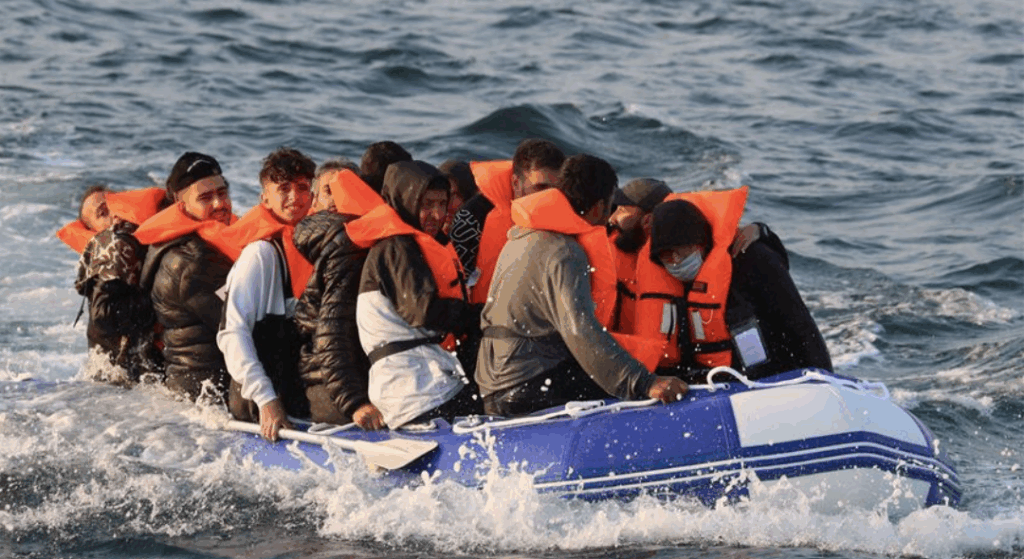Written by: Mara Matilda Munteanu
Edited by: Bérénice Louveau

A group of people thought to be migrants crossing the Channel in a small boat headed in the direction of Dover, Kent.
The English Channel, an arm of the Atlantic Ocean that separates Southern England from Northern France, has become a symbol of tragedy for Europe’s broken migration system. With each sinking boat or body recovered from the water, the world is shown that these tragedies are not isolated misfortunes, but rather a reflection of policies that prize deterrence over ethics. These recurring tragedies oblige a rethinking of security, not as border control, but as the protection of human life enshrined in the Universal Declaration of Human Rights and consistent with the European Convention on Human Rights.
Media coverage of these tragedies has revealed a painful amount of migrants being forced into unsafe crossing conditions under the gaze of authorities who were instructed to prevent departures but not to rescue. In some instances, the French Police have been caught wading into shallow waters off a beach in Boulogne and attempted to deflate and slash boats filled with men, women, and children, before they left the shore, leaving them stranded in shallow, cold water. Such measures meant to discourage crossings only push people into greater peril. These incidents demand scrutiny: Are Europe’s current maritime deterrence measures compliant with International Law and the Law of the Sea?
Desperation takes over as the sea calms, and the number of crossings becomes overwhelmingly high. By June 2025, 2,330 people who arrived by small boats in the UK were returned to their home country, and by July 2025, the British government had concluded that 25 of the attempted crossers were gang leaders. Not only did they have their assets frozen, but they were also barred from entering the UK. On September 27, 2025, two women died attempting to cross the English Channel. The incident occurred overnight off the coast of Northern France, when around 100 people attempted to cross over in what seemed to be a makeshift boat. According to French official Isabelle Fradin-Thirode, cited by the AFP news agency, sixty people managed to get rescued and were taken care of, two women died, and a couple with a child suffered from moderate hyperthermia and were rushed to the hospital in Boulogne. Each arrival amplifies domestic political pressures on France and the United Kingdom to protect their borders and project control. Yet, this focus on enforcement obscures the deeper crisis: the lack of legal and safe pathways that would make crossings unnecessary in the first place.
Agreements between France and the UK have been heavily focused on symbolic gestures, rather than sustainable solutions, as seen with the ‘one in one out deal’. This agreement, under which both countries have pledged to return an equal number of migrants to one another, has produced only a couple of transfers. The pilot project welcomed a family of three with a small child who were given a three-month visa, with no right to work or access to public funding. This move was followed by the expulsion of four present migrants in the UK. This agreement has attracted sharp legal criticism, and French civil society groups argue that this agreement was enacted without parliamentary action, undermining domestic and international protection standards.
Beyond this agreement, the French government has authorized police officials to intercept small boats up to 300 meters from shore. Furthermore, the European Union’s Pact on Migration and Asylum prioritizes efficient removal of migrants over protection of human life, promoting accelerated screening and transfers to “safe countries”. As a result, these measures frame migration as a problem of control rather than human security. These framings have also impacted public discourse and vision. The UK has experienced an increase in referencing the arrival of migrants as “illegal” or “unauthorized” during parliamentary debates, whereas discussions of refugee and humanitarian duty have decreased. Thus, migration has been rhetorically transformed from a protection issue to a security threat.
The consequences of Europe’s securitized approach are most visible in the human tool. Women, children, and other vulnerable groups are disproportionately exposed to danger during crossings due to harsh weather, overcrowded boats, and delayed or denied rescue. Indeed, women and children are more likely to experience sexual violence, exploitation, and medical neglect during their journeys, while undersupervised minors are more likely to be reported as missing or dead, yet these experiences are rarely recognized as sufficient to grant asylum. These vulnerabilities showcase the limitations of deterrence policies and emphasize how fast-track asylum procedures and “safe countries” presumptions can expose those most at risk to heightened risk.
These recurring tragedies demand a redefinition of security and policies that are compliant with the Universal Declaration of Human Rights and the European Convention on Human Rights and consistent with the protection of human life, in line with international human rights commitments. Europe’s response to migration must prioritize safety, dignity, and accountability over control and deterrence.
